



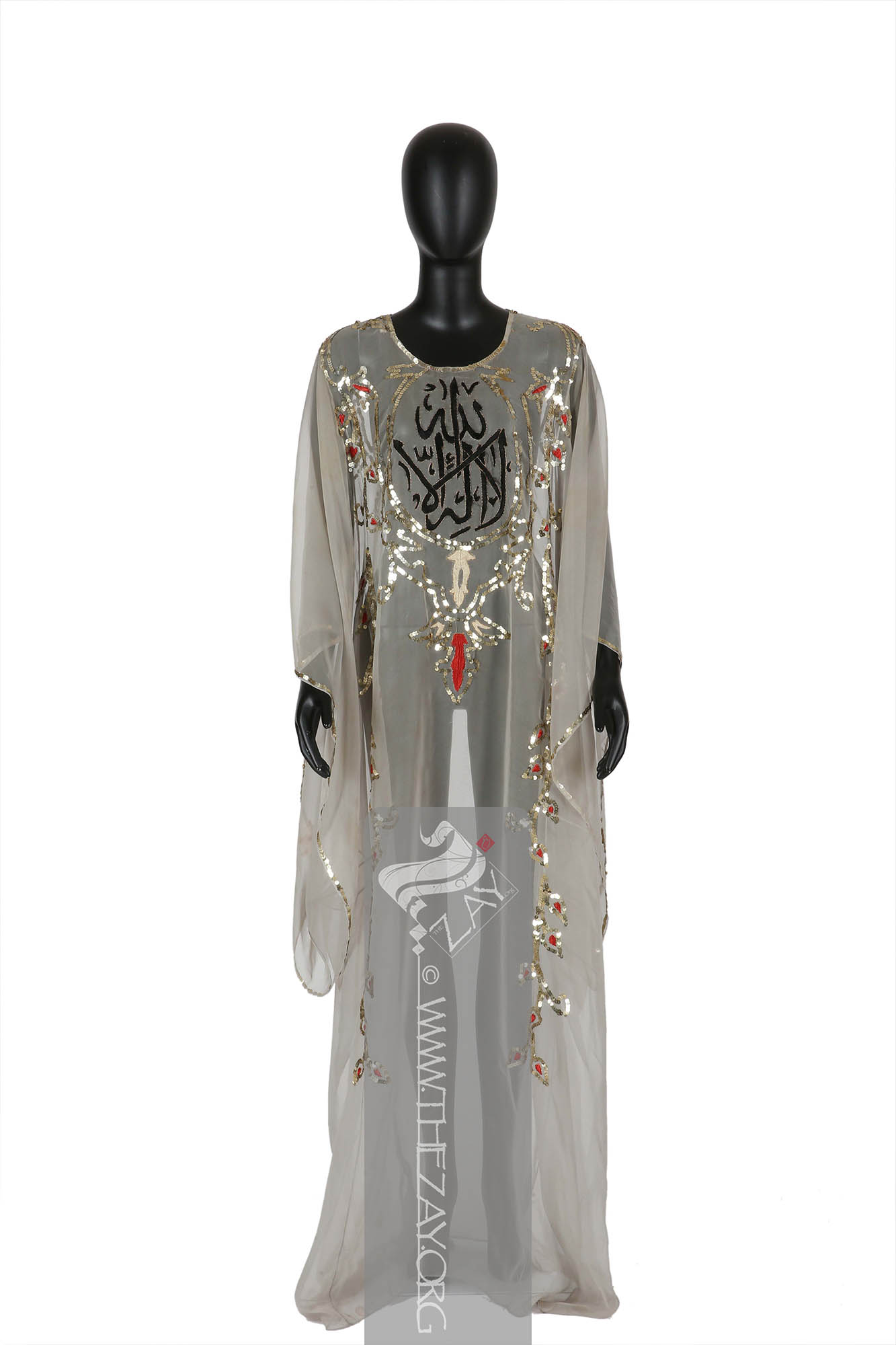
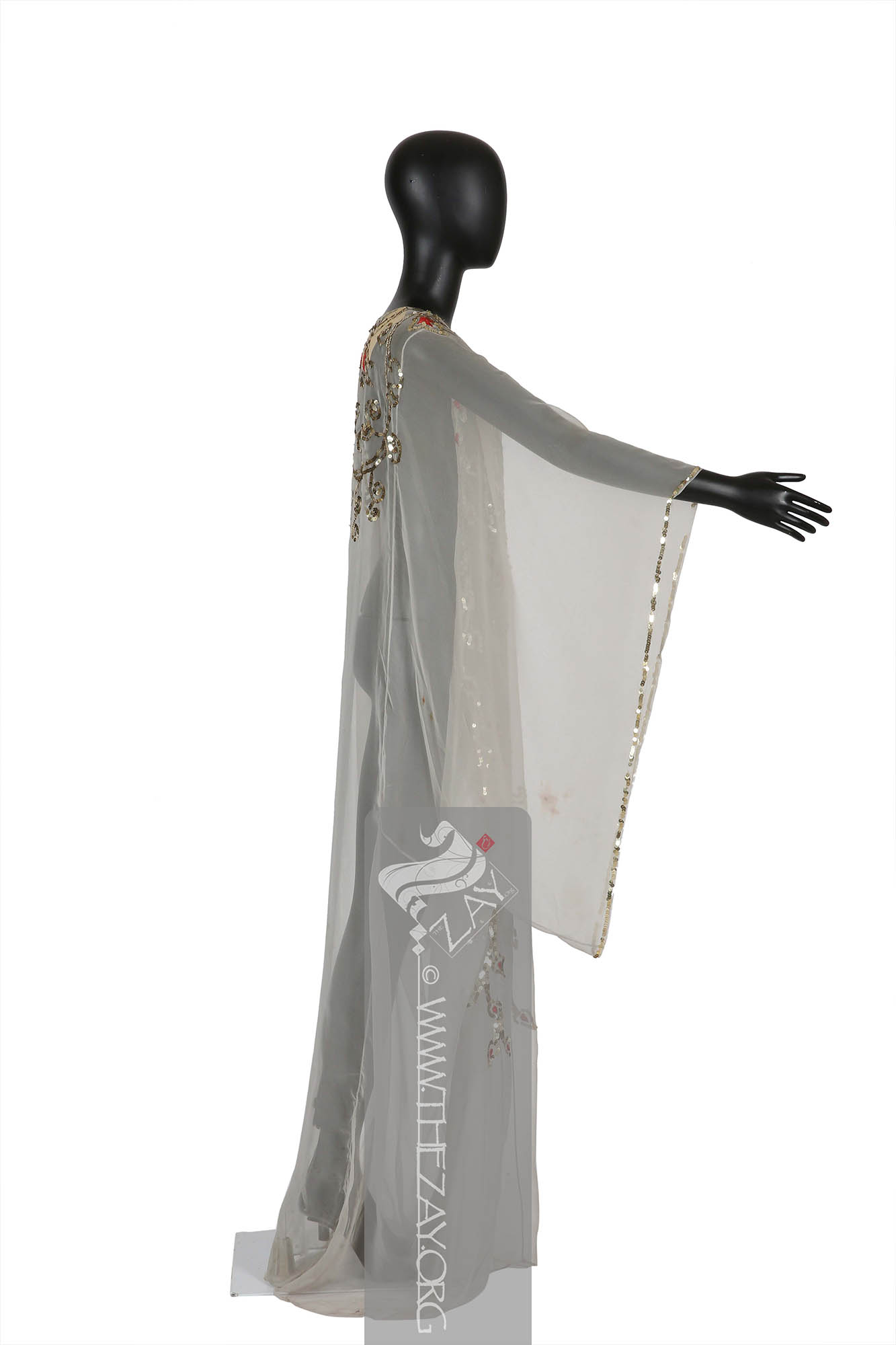


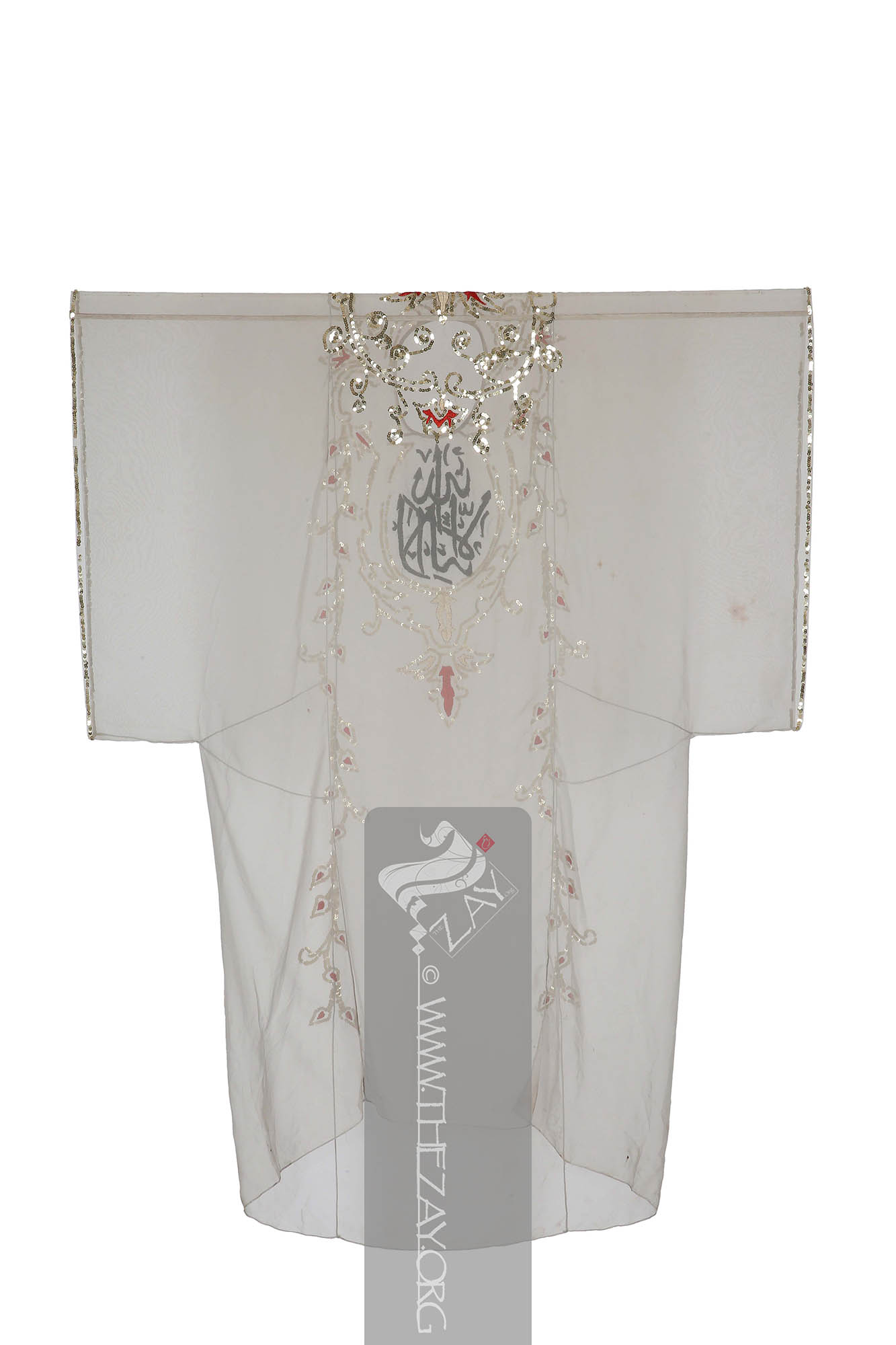

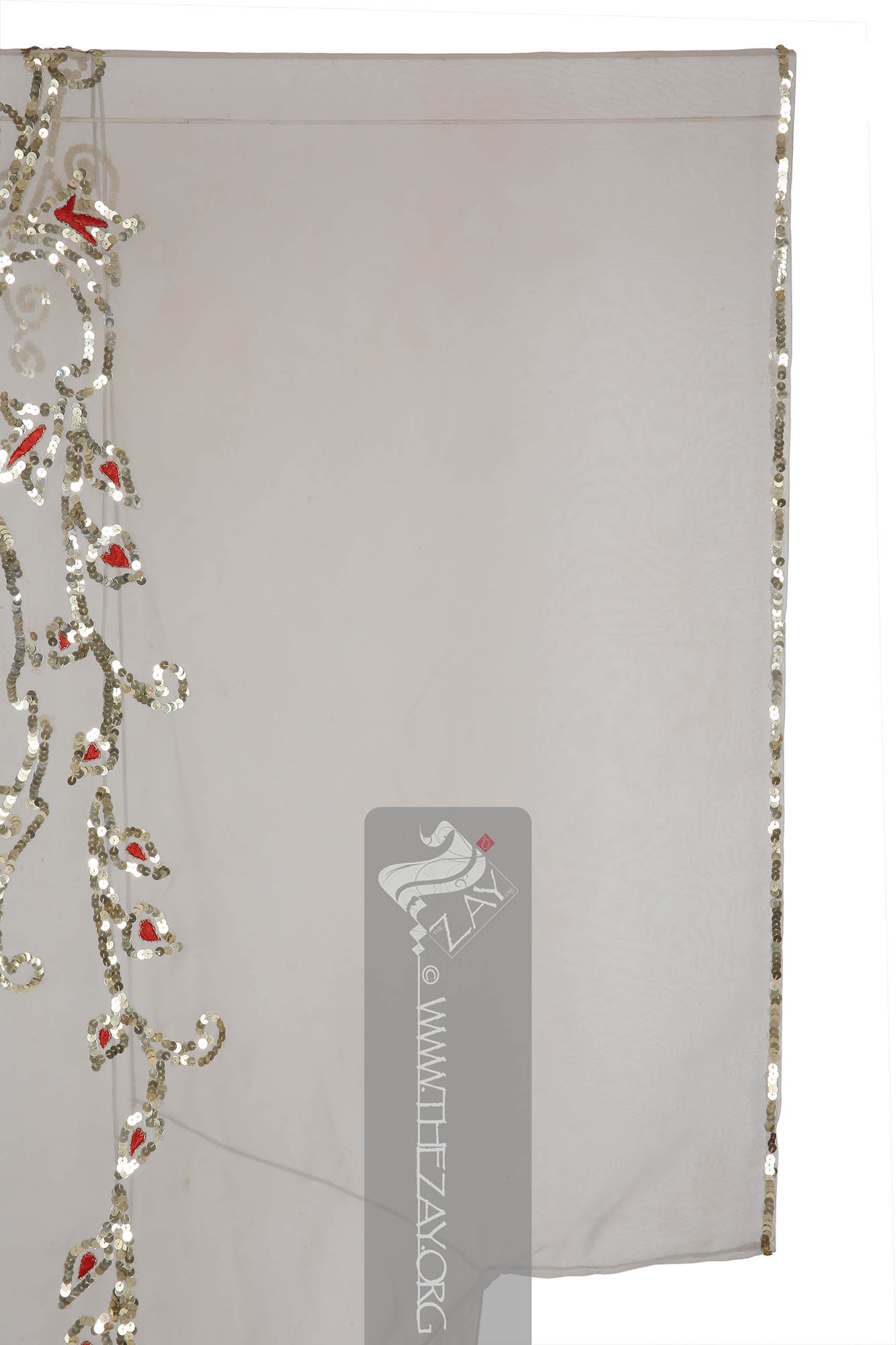
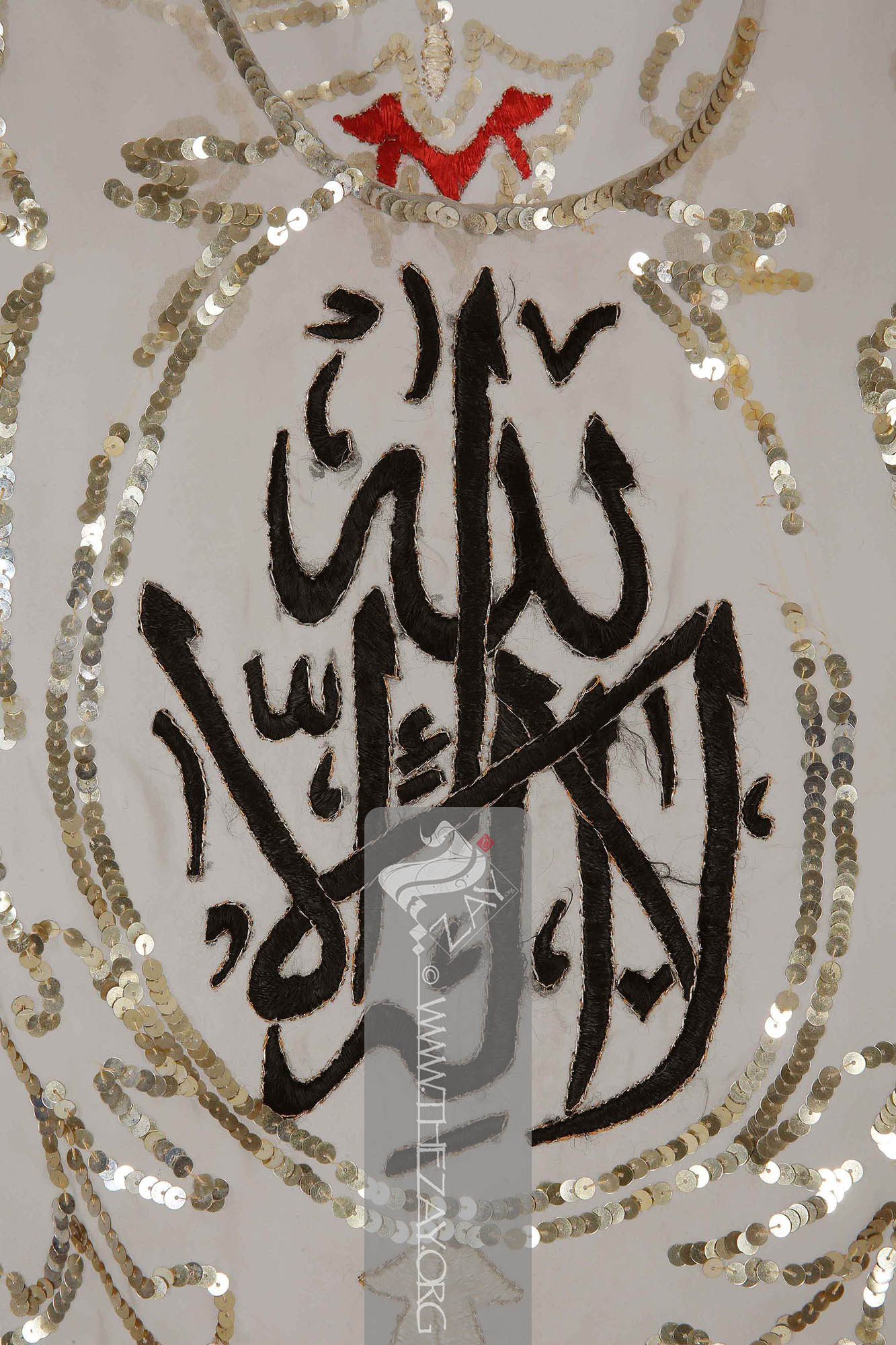

| Local Name | Hashmi, Thawb |
| Object Category | Overgarment |
| Gender | Female |
| Date of object | c. 20th century |
| Place Of orgin | Iraq |
| Region | Iraq |
| Object Range | - |
| Dimensions | Length: 155 cm Width: 135 cm |
| Materials | Silk Metal |
| Technique | Machine Stitched Hand Embroidered |
| Color | |
| Motif | Floral Calligraphy |
| Provenance | Gifted, Sulafah al Zahawi, Iraq 1996 |
| Location | The Zay Zay: (Arabic: costume, Pl. azyaā’), a set of clothes in a style typical of a particular country or historical period. Initiative |
| Status | In Storage |
| ZI number | ZI1996.500890.1 IRAQ |
Object Note
Part of a lot with two more items (ZI1996.500890.2 IRAQ, ZI1996.500890.3 IRAQ) also in the collection.
Object History
This piece was gifted to Dr. Reem Tariq
Ṭariq: (Arabic; Synonym: tulle_bi_talli; talli; badla; khus_dozi ), series of small metal knots made on a woven net ground as embellishment. The term is commonly used in the Levant Arab region specifically in Lebanon. Ṭariq: (Arabic; Synonym: tulle_bi_talli; talli; badla; khus_dozi ), series of small metal knots made on a woven net ground as embellishment. The term is commonly used in the Levant Arab region specifically in Lebanon.
Dr Reem’s mother-in-law commissioned Iraqi Fashion (Dar al Aziya’ al Iraqiyah) - now renamed Iraqi House of Fashion – for making the piece. It was bequeathed to her granddaughter, Mae Noaf Al Kalamchi.
Sulafah al Zahawi was an Iraqi socialite renowned for her style and fashion. She is a descendant of the clan of the great Iraqi poet Jamil Sidiqi al Zahawi.
Born in Baghdad in 1929, to Dhafir Rashid al Zahawi, and his wife Najiyah Baban, she graduated with a BA in journalism from The American University Cairo in 1951-52. She married Mustafa Abdul Karim al Kalamchi in 1955 and bore him a son, Bashar al Kalamchi (Dr. Reem’s husband), and a daughter, Athbah al Kalamchi.
Though she only sang amongst friends and relatives, she was known for her immaculate voice, often compared to the renowned Arab diva Umm Kalthum who was a personal friend of hers. She passed away and was buried in Italy in 2006.
Iraqi Fashion House (Dar al Aziya’ al Iraqiyah) was established by H.E. Friyal Al Kilidar in 1970 and remained under her directorship until 2005. It was the first and only one of its kind that aimed to display folkloric Iraqi costumes depicting the history of Iraq by reinterpreting the costumes of the people who inhabited the land and the nation states that were formed, dating from ancient Mesopotamia to the present. It also aimed to display the latest local and international fashion trends and showcase the collective Iraqi artists, calligraphers, poets, and designers.
Unfortunately, after the second Gulf War, it was plundered and looted to be rebuilt and reopened as the Iraqi House of Fashion in 2005, with new aspirations and directives. As for its founder and former director, Friyal Al Kilidar, she currently resides in the United States.
Object Features
This is a traditional Iraqi-style woman’s tunic robe (thawb
Thawb: (Arabic: thawb, Pl. Athwāb/thībān), can be pronounced thobe
Thobe: (Arabic: thawb, Pl. Athwāb/thībān), can be pronounced thawb or tobe
Tobe: (Arabic: thawb, Pl. Athwāb/thībān), can be pronounced thawb or thobe based on locale. The standard Arabic word for ‘fabric’ or ‘garment’. It can refer to a qamīs-like tunic worn by men and women in the Arabian Peninsula, Iraq, the southern and south-western ports and islands of Iran, and some countries in East and West Africa. More specifically, it can refer to the square-shaped Bedouin overgarment worn by women. based on locale. The standard Arabic word for ‘fabric’ or ‘garment’. It can also refer to a qamīs-like tunic worn by men and women in the Arabian Peninsula, Iraq, the southern and south-western ports and islands of Iran, and some countries in East and West Africa. More specifically, it can refer to the square-shaped Bedouin overgarment worn by women. or tobe
Tobe: (Arabic: thawb, Pl. Athwāb/thībān), can be pronounced thawb or thobe based on locale. The standard Arabic word for ‘fabric’ or ‘garment’. It can refer to a qamīs-like tunic worn by men and women in the Arabian Peninsula, Iraq, the southern and south-western ports and islands of Iran, and some countries in East and West Africa. More specifically, it can refer to the square-shaped Bedouin overgarment worn by women. based on locale. The standard Arabic word for ‘fabric’ or ‘garment’. It can also refer to a qamīs-like tunic worn by men and women in the Arabian Peninsula, Iraq, the southern and south-western ports and islands of Iran, and some countries in East and West Africa. More specifically, it can refer to the square-shaped Bedouin overgarment worn by women in the Arabian Gulf region. ), often locally referred to in Iraq as the (hashmi
Hashmī: (Arabic: Hashim (House of) – an Arab royal family from the Banu Hashim clan of the Quraysh tribe), a type of elaborately decorated women’s traditional garment or thawb from Iraq that was named after the royal family that ruled Iraq until the mid 20th century.
The hashmi
Hashmī: (Arabic: Hashim (House of) – an Arab royal family from the Banu Hashim clan of the Quraysh tribe), a type of elaborately decorated women’s traditional garment or thawb from Iraq that was named after the royal family that ruled Iraq until the mid 20th century. Kalabdūn: (Hindustani: kalabattu / kalabattun gold or silver threads; or Dravidian and Sanskrit: pattu or patt – a kind of fine fibre or silk; or Sanskrit: kalavatu – fine material), the gold wire used in embroidery and other embellishments on textiles and fabrics.
While the neckline of the hashmi
Hashmī: (Arabic: Hashim (House of) – an Arab royal family from the Banu Hashim clan of the Quraysh tribe), a type of elaborately decorated women’s traditional garment or thawb from Iraq that was named after the royal family that ruled Iraq until the mid 20th century. Pulek: coloquilal Iraqi meaning sequin, in Egyptian and levant dialects it is pronounced (folek), also known by (tirtir).
The pattern along the front seamline also in sequins (pulek
Pulek: coloquilal Iraqi meaning sequin, in Egyptian and levant dialects it is pronounced (folek), also known by (tirtir).
The centre of the front (yoke Yoke: (Synonym: Bodice_Yoke), a structured pattern fitted at the shoulders defining the structure of women’s garments. Introduced in c. 1880s it defines the transition between the upper and lower parts of the garments and can now be found stitched-in where the blouse is separated from the skirt by a horizontal seam. ) comprises a wreath-shaped floral bouquet with Arabic calligraphy in the centre in black silk floss Floss: (Old French: flosche – nap of velvet), is a type of silk fibre obtained from the cocoons of wild silkworms. It is characterized by its long, fluffy fibers that are not tightly woven, making it ideal for use in various textile applications such as embroidery, lace-making, and sewing. thread embroidery with a floral base in ivory and coral Coral: (Greek: korallion, probably from Hebrew: goral – small pebbles), is a pale to medium shade of pink with orange or peach undertones, resembling the colour of certain species of coral. silk floss Floss: (Old French: flosche – nap of velvet), is a type of silk fibre obtained from the cocoons of wild silkworms. It is characterized by its long, fluffy fibers that are not tightly woven, making it ideal for use in various textile applications such as embroidery, lace-making, and sewing. thread satin_stitch Satin_stitch: (Synonym: Damask Stitch), is a type of flat embroidery stitch that creates a satin like smooth and shiny surface by closely spaced stitches, covering an entire area or shape. embroidery.
The (yoke Yoke: (Synonym: Bodice_Yoke), a structured pattern fitted at the shoulders defining the structure of women’s garments. Introduced in c. 1880s it defines the transition between the upper and lower parts of the garments and can now be found stitched-in where the blouse is separated from the skirt by a horizontal seam. ) of the piece displays three panels filled with embroidered floral and foliage patterns along thin, wavy vines. The vines and the foliage are executed with satin_stitch Satin_stitch: (Synonym: Damask Stitch), is a type of flat embroidery stitch that creates a satin like smooth and shiny surface by closely spaced stitches, covering an entire area or shape. embroidered metallic lurex, and the floral patterns are produced with flower-shaped plastic sequins.
This floral arrangement continues across the two shoulders to the back of the yoke Yoke: (Synonym: Bodice_Yoke), a structured pattern fitted at the shoulders defining the structure of women’s garments. Introduced in c. 1880s it defines the transition between the upper and lower parts of the garments and can now be found stitched-in where the blouse is separated from the skirt by a horizontal seam. , however, without the calligraphic panel. Although the piece is thoroughly machine-stitched, the embroidery is hand-embroidered.
Although worn and used in Iraq by an Iraqi family and styled into a typical traditional Arab garment, it could have been crafted in India, as was the traditional practice. Usually, fabric such as this was often crafted and designed in the subcontinent for the Arab market for tailoring women’s garments such as these.
This particular example is important as it was made as part of the post-war period of the Iraqi fashion House. This is a rare a valuable example of the work of that period which will not be repeated.
Links
Charuga: (Possibly Kurdish), a mantle-like embroidered women’s traditional garment from the Qaraqosh region in northern Iraq, traditionally fastened at the shoulder. Historically worn by field workers, it helped conceal dust and dirt, making them less visible during labour, it is a festive garment worn sparingly during festivals and other special occasions.
from Northern Iraq Has Arrived at the TRC!, www.trc-leiden.nl/trc/index.php/en/blog/1378-the-charugaCharuga: (Possibly Kurdish), a mantle-like embroidered women’s traditional garment from the Qaraqosh region in northern Iraq, traditionally fastened at the shoulder. Historically worn by field workers, it helped conceal dust and dirt, making them less visible during labour, it is a festive garment worn sparingly during festivals and other special occasions.
-from-northern-iraq-has-arrvied-at-the-trc. Accessed 29 Jan. 2024.